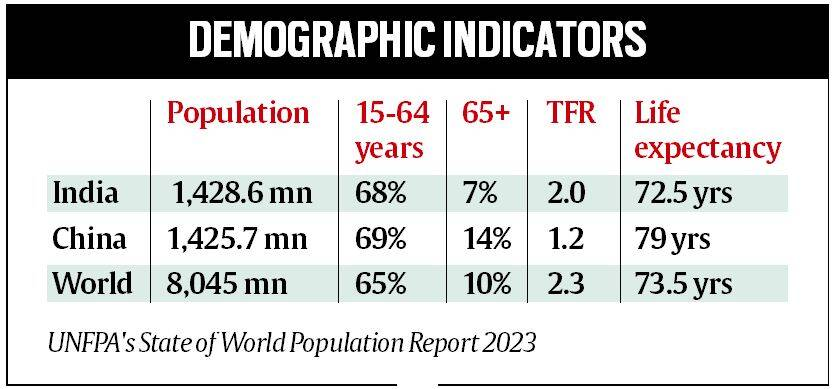Geography
Population Survey in China
- 06 Nov 2023
- 11 min read
For Prelims: Population Survey in China, Population Policies of China, United Nations, National Family Health Survey (NFHS).
For Mains: Population Survey in china, Population and associated issues, Poverty and developmental issues.
Why in news?
Recently, China has started polling 1.4 million people in a survey on population changes, as authorities struggle to incentivise people to have more children amid a declining birth rate and the first population drop in more than six decades.
- China is experiencing a declining birth rate and a population drop for the first time in over 60 years, with a decrease of approximately 850,000 people in 2022.
- The 2022 population decline is the first since 1961, which was the last year of China's Great Famine.
What Have Been China’s Policies for Population So Far?
- One Child Policy:
- China embarked upon its one-child policy in 1980, when its government was concerned that the country’s growing population, which at the time was approaching one billion, would impede economic progress.
- Chinese authorities have long hailed the policy as a success, claiming that it helped the country avert severe food and water shortages by preventing up to 40 crore people from being born.
- It was a source of discontent, as the state used brutal tactics such as forced abortions and sterilisations.
- It also met criticism and remained controversial for violating human rights, and for being unfair to the poor.
- China embarked upon its one-child policy in 1980, when its government was concerned that the country’s growing population, which at the time was approaching one billion, would impede economic progress.
- Two Child Policy:
- From 2016, the Government of China finally allowed two children per couple– a policy change that did little to arrest the rapid fall in population growth.
- Three Child Policy:
- It was announced after China’s 2020 census data showed that the country’s rate of population growth is falling rapidly despite the 2016 relaxation.
- The country’s fertility rate has dropped to 1.3, far below the replacement level of 2.1 required for a generation to have enough children to replace it.
- The United Nations expects China’s population to begin declining after 2030, but some experts say this could happen as early as in the next one or two years.
What are the Concerns over the Falling Population in China?
- Decreased Labour:
- When the young population in a country declines, it creates labour shortages, which have a major detrimental impact on the economy.
- Increased Social Spending:
- More older people also means that demands for healthcare and pensions can soar, burdening the country’s social spending system further when fewer people are working and contributing to it.
- Critical for Developing Nations:
- China faces a unique challenge of population decline as a middle-income country that relies on labor-intensive sectors, unlike rich countries ( like Japan and Germany) that can invest in capital and technology. This could reduce its economic growth and affect other developing countries like India.
- The population decline could have various impacts on the world, such as slowing down the global economic growth and disrupting the supply chains that depend on China’s manufacturing and exports.
- It could also create opportunities and challenges for other countries to fill the gap in the global labor market and consumer demand.
What are the World's Population Trends?
- World’s Population:
- The world’s population reached 8 billion people in mid-November 2022 from an estimated 2.5 billion people in 1950, a milestone in human development. While it took the global population 12 years to grow from 7 to 8 billion.
- India’s Population:
- According tot he United Nations data, India has surpassed China to become world's most populous nation with 142.86 crore people in 2023.
- 25% of India's population is in the age group of 0-14 years, 18% in the 10-19 age group, 26% in the age bracket of 10-24 years, 68% in the 15-64 years age group, and 7% above 65 years.
- According tot he United Nations data, India has surpassed China to become world's most populous nation with 142.86 crore people in 2023.
- Regions with Highest Population Growth:
- More than half of global population growth between now and 2050 is expected to occur in Africa.
- Africa has the highest rate of population growth among major areas. The population of sub-Saharan Africa is projected to double by 2050.
- In Syria, the population grew by about 6.39% compared to the previous year, making it the country with the highest population growth rate in 2023.
- Countries with Populations Declining:
- Several countries are expected to see their populations decline by more than 15% by 2050, including Bosnia and Herzegovina, Bulgaria, Croatia, Hungary, Japan, Latvia, Lithuania, Republic of Moldova, Romania, Serbia, and Ukraine.
- Cook Islands has the highest population decline rate of 2.31 % in 2023.
What Lessons can India Learn from Such A Demographic Shift in China?
- Avoid Stringent Measures:
- Stringent population control measures have landed China in a human crisis that was inevitable. If coercive measures like a two-child limit are enforced, India’s situation could be worse.
- Women Empowerment:
- The proven ways to lower the fertility rate are to give women the control over their fertility and ensure their greater empowerment through increased access to education, economic opportunities and healthcare.
- As a matter of fact, China’s fertility reduction is only partly attributable to coercive policies, and is largely because of the sustained investments the country had made in education, health and job opportunities for women.
- Need to Stabilize Population:
- India has done very well with its family planning measures and now it is at replacement level fertility of 2.1, which is desirable.
- It needs to sustain population stabilization because in some States like Sikkim, Andhra Pradesh, Delhi, Kerala and Karnataka, the total fertility rate is way below replacement level, which means it can experience in 30-40 years what China is experiencing now.
What are the Steps taken by India to Control Population ?
- India became one of the first developing countries to come up with a state-sponsored family planning programme in the 1950s.
- A population policy committee was established in 1952.
- In 1956, a Central Family Planning Board was set up and its focus was on sterilisation.
- In 1976, GOI announced the first National Population Policy.
- National Population Policy, 2000 envisaged achieving a stable population for India.
- The Policy aims to achieve a stable population by 2045.
- One of its immediate objectives is to address the unmet needs for contraception, health care infrastructure, and personnel and provide integrated service delivery for basic reproductive and child health care.
- National Family Health Survey (NFHS)
- Realising the potential of education in tackling the problems of growing rate of population, the Ministry of Education launched a Population Education Programme with effect from 1980.
- The Population Education programme is a central sector scheme designed to introduce Population Education in the formal education system.
- It has been developed in collaboration with the United Nations Funds for Population Activities (UNFPA) and with the active involvement of the Ministry of Health and Family Welfare.
Conclusion
- India has a chance to benefit from its young population (demographic dividend) until the 2040s, similar to how China did until 2015.
- But this opportunity depends on providing good job opportunities for the youth. Without those opportunities, India's demographic advantage could become a problem instead of a benefit.
UPSC Civil Services Examination, Previous Year Questions (PYQs)
Prelims
Q1. In the context of any country, which one of the following would be considered as part of its social capital? (2019)
(a) The proportion of literates in the population
(b) The stock of its buildings, other infrastructure and machines
(c) The size of population in the working age group
(d) The level of mutual trust and harmony in the society
Ans: (d)
Q2. India is regarded as a country with “Demographic Dividend”. This is due to (2011)
(a) Its high population in the age group below 15 years
(b) Its high population in the age group of 15-64 year
(c) Its high population in the age group above 65 years
(d) Its high total population
Ans: (b)
Mains
Q1. Discuss the main objectives of Population Education and point out the measures to achieve them in India in detail. (2021)
Q2. ‘’Empowering women is the key to control the population growth.’’ Discuss. (2019)
Q3. Critically examine whether growing population is the cause of poverty or poverty is the main cause of population increase in India. (2015)









